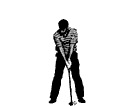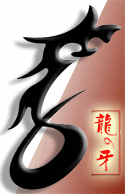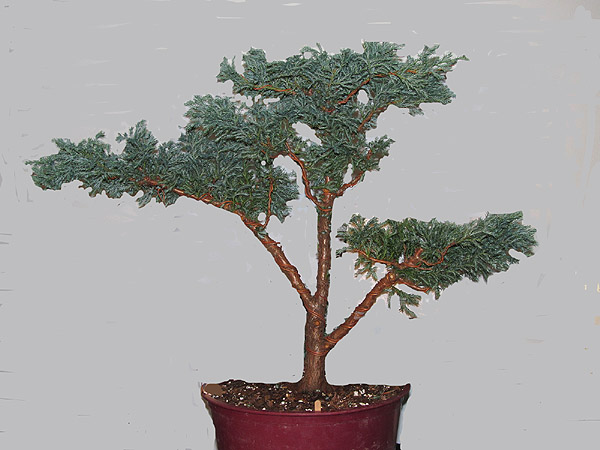Flat Top Style
+13
marcus watts
coh
Robert Steven
Randy_Davis
Sam Ogranaja
Russell Coker
carlos
Tom Simonyi
my nellie
Brett Summers
alex e
fiona
Rob Kempinski
17 posters
Page 1 of 2
Page 1 of 2 • 1, 2 
 Flat Top Style
Flat Top Style
When is a tree with a flat top not a flat top????
How about this? A Japanese White Pine

Or this?

Getting flatter?

Some styles are defined by trunk configuration such as formal upright and slanting or cascade. Some are defined by branch configuration such as windswept. Flat top style bonsai are defined by a branch placement. If a tree has a flat top it is a flat top style. One can have a formal upright flat top style (like many bald cypress), or an informal upright flat top (like perhaps an Acacia tree in the African veldt) or a slanting flat top like the Japanese Black Pine I posted in the other thread or many other combinations as the trees posted above. There can be lots of variation around the world so if you have a flat top (tree not head) lets see it.
How about this? A Japanese White Pine

Or this?

Getting flatter?

Some styles are defined by trunk configuration such as formal upright and slanting or cascade. Some are defined by branch configuration such as windswept. Flat top style bonsai are defined by a branch placement. If a tree has a flat top it is a flat top style. One can have a formal upright flat top style (like many bald cypress), or an informal upright flat top (like perhaps an Acacia tree in the African veldt) or a slanting flat top like the Japanese Black Pine I posted in the other thread or many other combinations as the trees posted above. There can be lots of variation around the world so if you have a flat top (tree not head) lets see it.

Rob Kempinski- Member
 Re: Flat Top Style
Re: Flat Top Style
Brave move, Rob, but the correct one in taking this discussion away from Billy's Brevard Show one. I think it may be doomed to fall victim to the "that's not how the Japanese do it" school of thought, but I am comfortable with your notion of this style's closer relationship with other approaches in particular the Chinese.
But what has always concerned me about it is that sometimes people will call a tree a flat-top style when really all it is is a poorly executed version of any one of a number of other styles. Inventing a new style is perfectly ok in my book when an artistic breakthrough is made, but just giving something a new name when it's really little more than to cover up a styling mistake is not.
Assuming then that, as will undoubtedly be the case, there are many "flat-top" trees that are good examples of the genre (I am tempted to include Amy's tree from the last thread here), there is for me another factor which is why I personally don't have any trees in this style. Again it is a personal thing and it is quite simply that I don't like it. I find it an ugly style and the last two pictures you posted are good examples of this. That last statement, it has to be said, is very much IMHO and does not mean that I think those are bad trees. I have not seen them in person but if someone who has tells me that they are perfectly executed then I will take their word for it.
And that I suspect is the nub of this discussion as I suspect I am not alone in viewing this as an ugly style or one which is used to cover mistakes. This makes it a very tricky topic to discuss I think as personal taste may just overrule any sort of objectivity. But hey, let's give it a shot - this forum is for learning and if there are some great examples of this style out there, then I might be a bit more convinced as to its validity.
Have at it - but please remember basic rules of manners and civility.
But what has always concerned me about it is that sometimes people will call a tree a flat-top style when really all it is is a poorly executed version of any one of a number of other styles. Inventing a new style is perfectly ok in my book when an artistic breakthrough is made, but just giving something a new name when it's really little more than to cover up a styling mistake is not.
Assuming then that, as will undoubtedly be the case, there are many "flat-top" trees that are good examples of the genre (I am tempted to include Amy's tree from the last thread here), there is for me another factor which is why I personally don't have any trees in this style. Again it is a personal thing and it is quite simply that I don't like it. I find it an ugly style and the last two pictures you posted are good examples of this. That last statement, it has to be said, is very much IMHO and does not mean that I think those are bad trees. I have not seen them in person but if someone who has tells me that they are perfectly executed then I will take their word for it.
And that I suspect is the nub of this discussion as I suspect I am not alone in viewing this as an ugly style or one which is used to cover mistakes. This makes it a very tricky topic to discuss I think as personal taste may just overrule any sort of objectivity. But hey, let's give it a shot - this forum is for learning and if there are some great examples of this style out there, then I might be a bit more convinced as to its validity.
Have at it - but please remember basic rules of manners and civility.

fiona- Member
 Flat top thingymajig
Flat top thingymajig
Brave Fiona very brave!!!but spot on :ThumbsUp:that said now I can get back to EBA 2011
Germany thread for some real!! Bonsai and some real!! inspiration
FCS (someone pass me a Valium)
Alex e
Germany thread for some real!! Bonsai and some real!! inspiration
FCS (someone pass me a Valium)
Alex e

alex e- Member
 Re: Flat Top Style
Re: Flat Top Style
When is a tree with a flat top not a flat top???? When they are from the School of Yangzhou 
I believe these trees are done in the Penjing school of Yangzhou where they only use palm fibre wiring. Although they do have a flat top they would be more correctly called Platform style with one to three levels of foliage or Cloud style when they have more. At first glance they look quite contrived but when compared with the very old pines in China's mountains they actually look very similar. A good example is the Welcome Pine. As with any penjing though there is less concern on making an exact copy of a miniature tree. The emphasis is on the poetry of nature. So some may see them as a more caricature of a real tree.
This episode of WOB has a fantastic section on them.
http://bonsaifarm.tv/index.php/download_file/view/165/
Recently we have been lucky to see some amazing penjing on this forum and others. I find the various penjing styles very intriguing when done well.
I don't think there is anything to giving a bad tree a new style name. I think any style done well will still smell like a rose no matter what name you give it. A bad style tree will stink with any name as well and I doubt giving it a different name would confuse many.
As too the examples shown here I think they are very well done. I may choose some others that would entertain the eye a little more to introduce the style but they are great examples none the less. The first one is a great example of looking like the Welcome Pine.
I can understand why the last one would be most hated by some but I find it brings a smile to my face by the excellent trunk movement then the thinness of the pads is almost daring or confronting as we would expect from a literati man showing how different he was from the rest. Cheeky for lack of better words.
I believe these trees are done in the Penjing school of Yangzhou where they only use palm fibre wiring. Although they do have a flat top they would be more correctly called Platform style with one to three levels of foliage or Cloud style when they have more. At first glance they look quite contrived but when compared with the very old pines in China's mountains they actually look very similar. A good example is the Welcome Pine. As with any penjing though there is less concern on making an exact copy of a miniature tree. The emphasis is on the poetry of nature. So some may see them as a more caricature of a real tree.
This episode of WOB has a fantastic section on them.
http://bonsaifarm.tv/index.php/download_file/view/165/
Recently we have been lucky to see some amazing penjing on this forum and others. I find the various penjing styles very intriguing when done well.
I don't think there is anything to giving a bad tree a new style name. I think any style done well will still smell like a rose no matter what name you give it. A bad style tree will stink with any name as well and I doubt giving it a different name would confuse many.
As too the examples shown here I think they are very well done. I may choose some others that would entertain the eye a little more to introduce the style but they are great examples none the less. The first one is a great example of looking like the Welcome Pine.
I can understand why the last one would be most hated by some but I find it brings a smile to my face by the excellent trunk movement then the thinness of the pads is almost daring or confronting as we would expect from a literati man showing how different he was from the rest. Cheeky for lack of better words.
Brett Summers- Member
 Re: Flat Top Style
Re: Flat Top Style
Why should we wonder about flat top "style" and why should we relate it with the Chinese penjing?
Isn't this "style" found in the African nature? Isn't this "style" the natural form of the African acacias? As well as Piernieef "style"?
I can see that the third example is the exaggeration of the "style" itself, but I think Fiona has well documented its virtues.
Why should we exclude one or the other "style" since this is portraying the natural growing habit of some species found only in this and not the other continent or part of the globe?
I hope this is a small contribution to further evolve this interesting conversation.
PS: if I am off topic, please excuse my ignorance...
Isn't this "style" found in the African nature? Isn't this "style" the natural form of the African acacias? As well as Piernieef "style"?
I can see that the third example is the exaggeration of the "style" itself, but I think Fiona has well documented its virtues.
Why should we exclude one or the other "style" since this is portraying the natural growing habit of some species found only in this and not the other continent or part of the globe?
I hope this is a small contribution to further evolve this interesting conversation.
PS: if I am off topic, please excuse my ignorance...

my nellie- Member
 Re: Flat Top Style
Re: Flat Top Style
my nellie wrote:Why should we wonder about flat top "style" and why should we relate it with the Chinese penjing?
Isn't this "style" found in the African nature? Isn't this "style" the natural form of the African acacias? As well as Piernieef "style"?
I can see that the third example is the exaggeration of the "style" itself, but I think Fiona has well documented its virtues.
Why should we exclude one or the other "style" since this is portraying the natural growing habit of some species found only in this and not the other continent or part of the globe?
I hope this is a small contribution to further evolve this interesting conversation.
PS: if I am off topic, please excuse my ignorance...
Again wit the Piernieef...just another quirk to make something more exotic...........
Last edited by carlos on Wed Oct 05, 2011 1:48 pm; edited 1 time in total
carlos- Member
 Re: Flat Top Style
Re: Flat Top Style
fiona wrote: ... there are many "flat-top" trees that are good examples of the genre (I am tempted to include Amy's tree from the last thread here), there is for me another factor which is why I personally don't have any trees in this style. Again it is a personal thing and it is quite simply that I don't like it. I find it an ugly style and the last two pictures you posted are good examples of this. That last statement, it has to be said, is very much IMHO and does not mean that I think those are bad trees. I have not seen them in person but if someone who has tells me that they are perfectly executed then I will take their word for it.
And that I suspect is the nub of this discussion as I suspect I am not alone in viewing this as an ugly style or one which is used to cover mistakes. This makes it a very tricky topic to discuss I think as personal taste may just overrule any sort of objectivity. But hey, let's give it a shot - this forum is for learning and if there are some great examples of this style out there, then I might be a bit more convinced as to its validity.
Have at it - but please remember basic rules of manners and civility.
I'm not sure it's a "brave" move, but I'm glad it was moved. We've beaten poor Billy's thread to death.
Anyway, I agree with you Fiona. I don't find any of those trees attractive either, except the first pine. It's not that I see those trees as wrong, they are what they are. If they were on my benches I'd be trying to "fix" them, to make them "bonsai" as I see it in my mind's eye. But I think there is a GIANT difference between those very contrived trees styled to fit a certain esthetic or "school", and trees like bald cypress here in the southern USA or trees on the African savanna. Those are the flat top trees that appeal to me.
Last edited by Russell Coker on Wed Oct 05, 2011 2:09 pm; edited 1 time in total

Russell Coker- Member
 Re: Flat Top Style
Re: Flat Top Style
I agree with Russell. Russell, are you going to or showing a tree at the NC Carolina Bonsai Expo?
I do have another question for everyone. Is it acceptable to use a different species to mimic a style not naturally occurring in that type of tree?
Have a great week!!!
Sam
I do have another question for everyone. Is it acceptable to use a different species to mimic a style not naturally occurring in that type of tree?
Have a great week!!!
Sam

Sam Ogranaja- Member
 Re: Flat Top Style
Re: Flat Top Style
Sam Ogranaja wrote: Is it acceptable to use a different species to mimic a style not naturally occurring in that type of tree?
Have a great week!!!
Sam
Sam,
I my mind anything is acceptable as long as you like it. Don't ask for general acceptance, you'll never get it! Just do what's right for you. This is an artform and everyone has an opinion (some good, some bad, some uninformed, some rigid to certain "rules"). For me, I do what I like and don't really give a fat rats ass about whether someone else likes it or not. It's not on their bench, it's on mine! If they want to change it they can buy the tree and do what they like to it. This judging stuff in bonsai is the thing I hate most about the hobby!
Randy
p.s. I am working on a flat top design (African in influence) with a Seiju Elm. It's what I have to work with. It's not the tree, it's the form that I'm looking for. Some have said that it's not right unless it's using acacia! Bahh humbug I say! I don't have an acacia to use, so I'll just use what I have and be happy with it!

Randy_Davis- Member
 Re: Flat Top Style
Re: Flat Top Style
Hi Sam.
I don't want to change the direction of this thread, so a couple of quick answers.
No, I don't plan on attending.
Some plant material grown as bonsai doesn't have a natural "tree" shape. Azaleas are generally styled into a pine tree shape, and for that reason (and others) it took a long time for satsuki to be considered legitimate bonsai in Japan. A few months ago Randy Davis showed an elm that he decided to style as an African savanna type flat top. I wasn't crazy about the idea, but everyone seemed to think it was wonderful. Maybe he'll see this and post pictures of his progress here.
Good, I see Randy has already beaten me to it! Let's see it Randy!
I don't want to change the direction of this thread, so a couple of quick answers.
No, I don't plan on attending.
Some plant material grown as bonsai doesn't have a natural "tree" shape. Azaleas are generally styled into a pine tree shape, and for that reason (and others) it took a long time for satsuki to be considered legitimate bonsai in Japan. A few months ago Randy Davis showed an elm that he decided to style as an African savanna type flat top. I wasn't crazy about the idea, but everyone seemed to think it was wonderful. Maybe he'll see this and post pictures of his progress here.
Good, I see Randy has already beaten me to it! Let's see it Randy!

Russell Coker- Member
 Re: Flat Top Style
Re: Flat Top Style
Russell Coker wrote:
Good, I see Randy has already beaten me to it! Let's see it Randy!
Russell,
Right at the moment the tree is being air layered so I can use the upper portion of the tree for other things. I should be able to start the design next spring and have some preliminary results by next fall. As always, this is a slow process so actual results may take 3 or 4 years to get a good looking canopy. I will however keep you upto date on the progress.
Randy

Randy_Davis- Member
 Re: Flat Top Style
Re: Flat Top Style
Let's hope you don't get your hands on too many of these then Russell, it would be a shame to see them all disappear into what we call Japanese style. The host of WOB Lindsay Farr talks of the world melting pot of Bonsai. Where he sees a merging of various styles from it's history. Robert Steven put it into some words in his first book where he states he has merged Penjing with a more Japanese style. (best memory of his words)
I noticed there was alot of talk about what would be accepted into major bonsai events. We know that deciduous trees with deadwood are not excepted in Japan yet that does not stop us from appreciating them in the western world. If a flat top style was not excepted in Japan is that any reason for us not to except it.
Personally I want to create bonsai that inspire/capture others attention. It is not at the top of my list to enjoy the hobby but I would be perplexed to spend this much time at something to have unimpressive trees. It simply relates to the notion that we all want to be loved. Off course we want others to love our work. It is an embedded notion that we see ourselves as special.
Yet if I created my trees just to please others that would also be pointless.
I think of bonsai appreciation much the same way I think of music. I like all styles when done well. I am mesmerised by the craftsmanship of the artist. Yet if I am honest there are certain styles of music that I probably just don't understand well enough to appreciate.
Personally I would be disappointed if the various schools of penjing became lost in the bonsai melting pot of the world. Although I don't see myself setting out to create a tree such as these I do see a real need to appreciate how bonsai has evolved around the world. As well as how these original bonsai are also evolving and merging with other country/peoples, styles.
I noticed there was alot of talk about what would be accepted into major bonsai events. We know that deciduous trees with deadwood are not excepted in Japan yet that does not stop us from appreciating them in the western world. If a flat top style was not excepted in Japan is that any reason for us not to except it.
Personally I want to create bonsai that inspire/capture others attention. It is not at the top of my list to enjoy the hobby but I would be perplexed to spend this much time at something to have unimpressive trees. It simply relates to the notion that we all want to be loved. Off course we want others to love our work. It is an embedded notion that we see ourselves as special.
Yet if I created my trees just to please others that would also be pointless.
I think of bonsai appreciation much the same way I think of music. I like all styles when done well. I am mesmerised by the craftsmanship of the artist. Yet if I am honest there are certain styles of music that I probably just don't understand well enough to appreciate.
Personally I would be disappointed if the various schools of penjing became lost in the bonsai melting pot of the world. Although I don't see myself setting out to create a tree such as these I do see a real need to appreciate how bonsai has evolved around the world. As well as how these original bonsai are also evolving and merging with other country/peoples, styles.
Brett Summers- Member
 Re: Flat Top Style
Re: Flat Top Style
Rob, can we use your first 3 pictures for our new book "The Five Schools of Chinese Penjing" ? I am still working on it and will send you the draft as soon as ready..and our book will answer to many of the questions here. Getting good pictures is the most difficult part of our project...

Robert Steven- Member

Robert Steven- Member
 Re: Flat Top Style
Re: Flat Top Style
Robert Steven wrote:Rob, can we use your first 3 pictures for our new book "The Five Schools of Chinese Penjing" ? I am still working on it and will send you the draft as soon as ready..and our book will answer to many of the questions here. Getting good pictures is the most difficult part of our project...
Yes Robert, a pleasure. I will send you a DVD with high res images plus a few more that I have from the BCI tour of China.
Looking forward to your book.
PS Brook Zhao also has a book coming out which covers some Chinese penjing styles. His is a nice tome. I had the honor of writing a forward for it.

Rob Kempinski- Member
 Re: Flat Top Style
Re: Flat Top Style
Robert, that picture of the acacia from your safari is beautiful...do you have any other pictures of those types of trees? Regarding the bonsai acacia - since you say you "made it last week", I assume that was the first styling? Looks like it has great potential. Nice size tree, too!
Chris
Chris

coh- Member
 Re: Flat Top Style
Re: Flat Top Style
OK...to post, or not to post...that is the question I've been debating since this thread started. Guess the answer I've come up with is, why the heck not?
I've got a flat-top chamaecyparis pisifera (Boulevard cypress) that I've started working on. I remember mentioning it in the previous thread (by Randy, I think, where he was talking about doing this with a Chinese Elm). My inspiration was some Monterey Cypress trees I've seen in California, which strongly resemble those Namibian acacias:

I picked up the cypress at a sale last fall after being inspired by a beautiful formal upright boulevard cypress I saw earlier in the summer. Unfortunately, the branch structure on this one would never support that style...but when I looked at it more closely I realized it looked a lot like the Monterey Cypress. So after thinking about it for a few months, I took the plunge and started cutting/wiring in early August. This is what I wound up with. Keep in mind this is step 1 of a long process...get a basic shape started and see how the tree reacts:

Those straight trunks and branches are going to be difficult to overcome...they're quite stiff, but that will be something to work on next year. If I can't get some movement I'll probably have to significantly modify the plan, or perhaps just plant it in the garden. I did leave some growth along the trunk that I've photoshopped out of this image, just in case. Any thoughts/suggestions would be welcome. Overall height about 24 inches, trunk base about 1.5".
Chris
I've got a flat-top chamaecyparis pisifera (Boulevard cypress) that I've started working on. I remember mentioning it in the previous thread (by Randy, I think, where he was talking about doing this with a Chinese Elm). My inspiration was some Monterey Cypress trees I've seen in California, which strongly resemble those Namibian acacias:

I picked up the cypress at a sale last fall after being inspired by a beautiful formal upright boulevard cypress I saw earlier in the summer. Unfortunately, the branch structure on this one would never support that style...but when I looked at it more closely I realized it looked a lot like the Monterey Cypress. So after thinking about it for a few months, I took the plunge and started cutting/wiring in early August. This is what I wound up with. Keep in mind this is step 1 of a long process...get a basic shape started and see how the tree reacts:

Those straight trunks and branches are going to be difficult to overcome...they're quite stiff, but that will be something to work on next year. If I can't get some movement I'll probably have to significantly modify the plan, or perhaps just plant it in the garden. I did leave some growth along the trunk that I've photoshopped out of this image, just in case. Any thoughts/suggestions would be welcome. Overall height about 24 inches, trunk base about 1.5".
Chris

coh- Member
 Re: Flat Top Style
Re: Flat Top Style
Chris - looks like a flat top in the making to me. Good luck with it.

Rob Kempinski- Member
 Re: Flat Top Style
Re: Flat Top Style
Yes Chris, there are plenty of inspiring trees out there in Namibia..

But in my opinion, simply resembling the style will not strong enough to depict the nuance of African nature. Ideal ramification, proper potting and other touching is neccessary in order to put them the soul, otherwise, they will end up as the "flat top" style...



But in my opinion, simply resembling the style will not strong enough to depict the nuance of African nature. Ideal ramification, proper potting and other touching is neccessary in order to put them the soul, otherwise, they will end up as the "flat top" style...



Robert Steven- Member
Page 1 of 2 • 1, 2 
 Similar topics
Similar topics» Flat-top Style
» Blue Bell twin trunk first styling
» Streblus asper (Clump style).... and other forest style material....
» Future Flat Top, Raintree
» Curvy Bald Cypress - First Training and Tips
» Blue Bell twin trunk first styling
» Streblus asper (Clump style).... and other forest style material....
» Future Flat Top, Raintree
» Curvy Bald Cypress - First Training and Tips
Page 1 of 2
Permissions in this forum:
You cannot reply to topics in this forum











